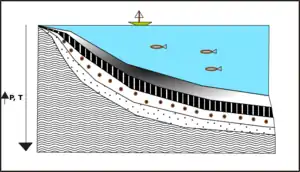Tectonic Burial is the deformation of rocks caused by extreme pressure over millions of years.[1] It often causes temperature evolutions and deep burials.[2] Tectonic burial is usually the result of continental collisions or subduction in a region.[3] An increase in burial depth leads to a weakened basin and basement but creates better preservation structure within the basement.[4]
Geologic Processes
Sedimentary Burial

Sedimentary burial is more typical when thinking of burial processes. Sedimentary burial is the deposition of sediments on and area of interest such as a sedimentary basin, oceans, or other locations typically leading to Diagenesis.
Tectonic Burial
Tectonic Burial specifically refers to burial of material on a area of interest as a result of tectonic processes such as a Thrust fault or other processes of crustal thickening. Tectonic burial is common in orogenic systems such as mountain belts or collisional zones. This is a critical part of the rock cycle and can lead to burial metamorphism and heating.
Evidence for tectonic burial
Radiometric Dating
One way of identifying a tectonic burial event is through radiometric dating.[5] Burial events may be radiometric dated by looking at the cooling of the event and its impact on the minerals within the formation.[5]
Metamorphism
When rocks or sediments get buried they begin to increase in temperature and pressure as the mass above accumulates. Metamorphism occurs at temperatures greater than 200 °C and pressures greater than 300 MPa.[3] Burial metamorphism overlaps with diagenesis with an increase in pressure and temperature.[3] Sedimentary rocks buried at depths of a couple kilo meters will begin generating temperatures above 300 °C without differential stress.[3]
Thermochronology
Tectonic burial events can be distinguished by Thermochronology. During a tectonic burial event rocks increase in heat until they reach their Closure temperature . These closure temperatures are an indication of burial depth history and are used by thermochronogists in dating a tectonic burial event.
Vitrinite Reflectance
Sediment deposition over a basin with organic material can create a primary component of coal, Vitrinite. High temperatures and pressures associated with Tectonic burial could produce vitrinite from woody organic material thus the presence of vitrinite may be a good indicator for a tectonic burial event.
Effects
Coalification
It has been debated that burial depth may play a role into the advancement of coalification.[6][7] Early in the 19th century it was thought to be caused purely by the pressure caused by burial, in some coal fields high ranking coal was found that made some geologists think that burial pressure increased the coalification rate.[7]
Oil
Oil can be another product of tectonic burial. Oil is created in this fashion over a series of steps starting with the deposition of carbonate sediments followed by cracking and multiple stages of filling of oil like inclusions.[8]
Pressure-Temperature-Time paths
One of the largest effects that tectonic burial has is a change in the pressure-temperature time paths, this can be identified by looking for metamorphism or by using thermochronology.[9]
Burial of greater depths have the ability to reset fission track dates.[10]
Examples
Tectonic burial in southern Apennines.[11]
In the southern Apennines fold and thrust belts, indicators record timing of exhumation of sedimentary units.
Tectonic burial in the Persian Gulf.[8]
Evidence for the timing of diagenesis and oil migration.
Tectonic burial and Coal production.[7]
Tectonic burial and its relationship to the advancement of coalification.
References
- ↑ Lynch, Gregory (1996). "Tectonic burial, thrust emplacement, and extensional exhumation of the Cabot nappe in the Appalachian hinterland of Cape Breton Island, Canada". Tectonics. 15 (1): 94–105. Bibcode:1996Tecto..15...94L. doi:10.1029/95TC02289. ISSN 1944-9194.
- ↑ Hardebol, N. J.; Callot, J. P.; Bertotti, G.; Faure, J. L. (June 2009). "Burial and temperature evolution in thrust belt systems: Sedimentary and thrust sheet loading in the SE Canadian Cordillera". Tectonics. AGU. 28 (23): n/a. Bibcode:2009Tecto..28.3003H. doi:10.1029/2008TC002335. S2CID 16037207. Retrieved 22 May 2012.
- 1 2 3 4 Nelson, Stephen (12 April 2018). "Types of Metamorphism". tulane.
- ↑ Lafosse, Manfred; Boutoux, Alexandre; Bellahsen, Nicolas; Le Pourhiet, Laetitia (September 2016). "Role of tectonic burial and temperature on the inversion of inherited extensional basins during collision". Geological Magazine. 153 (5–6): 811–826. Bibcode:2016GeoM..153..811L. doi:10.1017/S0016756816000510. ISSN 0016-7568.
- 1 2 Egawa, Kosuke; Lee, Yong Il (June 2011). "K-Ar dating of illites for time constraint on tectonic burial metamorphism of the Jurassic Nampo Group (West Korea)". Geosciences Journal. 15 (2): 131–135. Bibcode:2011GescJ..15..131E. doi:10.1007/s12303-011-0016-x. ISSN 1226-4806. S2CID 129306691.
- ↑ "Coal", Wikipedia, 2020-04-01, retrieved 2020-04-09
- 1 2 3 Shibaoka, M.; Bennett, A. J. R. (February 1976). "Effect of depth of burial and tectonic activity on coalification". Nature. 259 (5542): 385–386. Bibcode:1976Natur.259..385S. doi:10.1038/259385a0. ISSN 0028-0836. S2CID 4152397.
- 1 2 Burruss, R. C.; Cercone, K. R.; Harris, P. M. (1983-10-01). "Fluid inclusion petrography and tectonic-burial history of the Al Ali No. 2 well: Evidence for the timing of diagenesis and oil migration, northern Oman Foredeep". Geology. 11 (10): 567–570. Bibcode:1983Geo....11..567B. doi:10.1130/0091-7613(1983)11<567:FIPATH>2.0.CO;2. ISSN 0091-7613.
- ↑ England, P. C.; Thompson, A. B. (1984-11-01). "Pressure--Temperature--Time Paths of Regional Metamorphism I. Heat Transfer during the Evolution of Regions of Thickened Continental Crust". Journal of Petrology. 25 (4): 894–928. Bibcode:1984JPet...25..894E. doi:10.1093/petrology/25.4.894. hdl:20.500.11850/422845. ISSN 0022-3530.
- ↑ Tinker, Justine; de Wit, Maarten; Brown, Roderick (July 2008). "Mesozoic exhumation of the southern Cape, South Africa, quantified using apatite fission track thermochronology". Tectonophysics. 455 (1–4): 77–93. Bibcode:2008Tectp.455...77T. doi:10.1016/j.tecto.2007.10.009.
- ↑ Mazzoli, S.; D'Errico, M.; Aldega, L.; Corrado, S.; Invernizzi, C.; Shiner, P.; Zattin, M. (2008-03-01). "Tectonic burial and "young" (". Geology. 36 (3): 243–246. doi:10.1130/G24344A.1. ISSN 0091-7613.